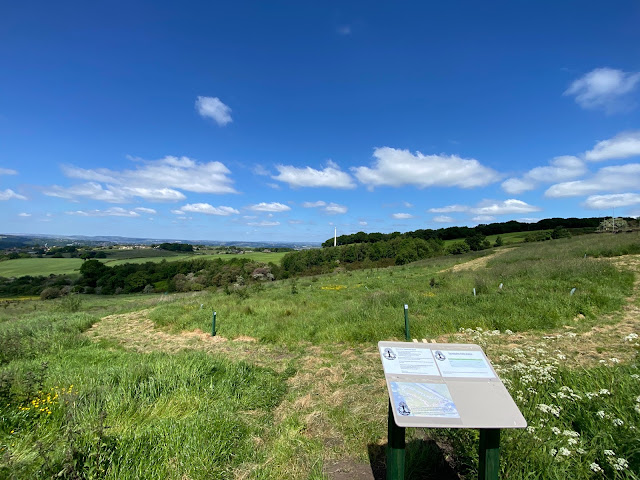Paths , spaces and Empurius Chewitt - aka The Beast
In many ways, open spaces are as important a part of the ecosystem that is a woodland, as the trees. Supporting wildlife and a healthy ecosystem is a key part of my project objectives. Paths and open spaces are an important part of enjoying a visit to a woodland for humans too - a second key objective. Carbon sequestration (via tree growth) is a third aim of my project. The first two objectives and the last one are a little incompatible, so balance is needed. As a result, I am trying to resist the urge to completely fill the place with as many trees as will fit. That isn’t what nature would (or will) do , so it isn’t what I am going to do.
The “artwork” at the top of the field was always designed to have paths around it , I always intended for there to be paths lower down too, I just hadn’t decided where.
Now that the trees were starting to define where the paths might be , and the grass was rapidly growing , how best to proceed? Mowing the grass can assist wildlife (to keep brambles and other coarse growth under control) and also helps people enjoy a walk around. It is especially good for wildlife if the mowing can be of different lengths so that different wild flowers can prosper in different parts of the “meadow”.
So how best to mow ?
A call to a mower salesmen or two , caused quite a bit of confusion. “You need a ride on” was a common refrain. They needed me to have a “ride on” more than I did - as they all quoted £7k+ for something I doubt would have managed the terrain and that I would struggle to store or transport (what ever I purchased had to fit in my camper van and had to take up minimal space in my garage). The next suggestion was a Honda work horse domestic mower at well over £1k. Again I suspected it would struggle as it wasn’t designed for rough surfaces or hillsides - though I know from personal experience that they are very robust mowers. Cutting wet or long grass with one would be “interesting” too - and it is likely that I would sometimes “fall behind” with the upkeep and things would occasionally be very over grown.
The next suggestion wasa big wheel industrial mower at £1600. This was getting closer to what might work , large off road tractor wheels at the back would help it keep moving over rough ground - but it was still a spinning blade mower - and they don’t like wet or long grass as they clog up a lot.
Nothing on offer seemed ideal and while I was resigned to spending well in excess of £1,000 to get the right tool for the job, I was worried that I was about to spend a lot of money for something that then would not do the job terribly well or would be a nightmare to use. My neighbour and helper next door , David, had an old Honda for sale for £150. I gave it a spin , doing a single circuit of the field. While it had impressive grunt , and was a bargain for a Honda , it simple wouldn’t manage long grass or wet grass. And I anticipate a lot of both over the coming years.
After being from by indecision for a while , the solution arrived in the form of a “scythe mower”. Like a giant set of hair clippers , they use a two oscillating blades at the front (think hedge trimmers on wheels) to cut through grass / small shrubs / brambles etc. They have good sized tractor wheels at the back and are “driven” so they will go up hill without too much effort.
I did some hunting around and lost out on a few eBay auctions before happening on my now good friend Empurius Chewitt. He was up for adoption on the internet for the cost of £729 and I would be his first dad. I measured and re-measured and I felt he could fit him into the camper van with some ramps. After deliberating endlessly I finally signed the adoption papers and he became family.
It’s great to know that no matter how long / wet / thick the grass gets (if I left it a year or two) I could still easily mow it. If brambles or other shrubs grow where I don’t want them , The Beast will deal with them. I can also cut some areas more often than others to give the variable lengths that wildlife will enjoy.
Before the new family member arrived I had estimated that a “full cut” would take me perhaps a weekend. I did the entire field, including new paths and the (new) orchard in just a little over 5 hours. Cutting the brand new paths was a real joy. As I cut, I daydreamed that these paths that had never existed until that very second, would be walked upon by people in 100 years time, perhaps they will, who knows. I hope so
At less than half the initial expected budget, this has been a really good purchase. I expect I will only mow perhaps 3-4 times per year, so with care and a bit of grease on his blades, Empurius should be around for a long time. He isn't too heavy to manage either, so I hope I will be able to keep mowing with him into old age.
The field looks so much more than a field now, it looks like something is happening and there is a plan. The paths will become more obvious as the other grass gets longer and different things start to grow, but it is still another exciting development.







Comments
Post a Comment